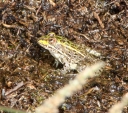Chiricahua Leopard Frog (Lithobates chiricahuensis)
** The Ramsey Canyon Leopard Frog (L. subaquavocalis) and the Chiricahua Leopard Frog (L. chiricahuensis) were merged to Lithobates chiricahuensis in 2013.
Read More..
Description: These frogs are similar in appearance to a small, extremely stocky bullfrogs with spots. They are olive to dark green in color, with charcoal spots. The groin features a yellowish pigmentation which may extend onto the posterior and abdomen. Lithobates chiricahuensis reaches a maximum size of 2 to 5.5 inches, with males generally smaller than females. Tadpoles are small and dark-colored.
Habitat: Its natural habitats are temperate forests, rivers, intermittent rivers, swamps, freshwater lakes, intermittent freshwater lakes, freshwater marshes, intermittent freshwater marshes, freshwater springs, ponds, and open excavations. Permanent aquatic habitats with well-oxygenated water and aquatic vegetation are necessary for the survival of this species. It usually occurs at altitudes of 3280 to 8530 feet. Lithobates chiricahuensis inhabits a wide variety of springs, streams, lakes, and ponds, as well as man-made habitats. The Nature Conservatory's Mimbres River Preserve is currently the home of one of the largest populations of this species.
Range: It is native to Mexico and the United States (Arizona and New Mexico).
Found in these States:
AZ |
CA |
NM
Diet: This species probably consumes a wide variety of insects and other invertebrates which are caught by the frog's long, quickly extendable tongue.
Reproduction: These frogs breed throughout June-August at elevations above 5900 feet, or during spring to late summer below 5900 feet. Permanent water is required for their reproduction. Eggs form clumped, spherical masses which are usually suspended on the surface of water, or on vegetation growing in water.
Status: It is threatened by habitat loss and chytrid fungus to such an extent that it has been eliminated from 80% of its former habitat. The Phoenix Zoo, Arizona's Department of Game and Fish, and the USFWS are trying to mitigate threats through captive breeding and reintroduction efforts.
Taxonomy: This species was placed in the genus Lithobates by Frost et al. (2006). However, Yuan et al. (2016, Systematic Biology, doi: 10.1093/sysbio/syw055) showed that this action created problems of paraphyly in other genera. Yuan et al. (2016) recognized subgenera within Rana for the major traditional species groups, with Lithobates used as the subgenus for the Rana palmipes group. AmphibiaWeb recommends the optional use of these subgenera to refer to these major species groups, with names written as Rana (Aquarana) catesbeiana, for example.
»» Kingdom: Animalia - Animals
»» Phylum: Chordata - Chordates
»» Subphylum: Vertebrata - Vertebrates
»» Class: Amphibia - Amphibians
»» Order: Anura - Frogs & Toads
»» Family: Ranidae - True Frogs
»» Genus: Lithobates
»» Species: Lithobates chiricahuensis - Chiricahua Leopard Frog
»» Subspecies: None
This article uses material from the Wikipedia article "Chiricahua Leopard Frog", which is released under the Creative Commons Attribution-Share-Alike License 3.0. Content may have been omitted from the original, but no content has been changed or extended.
|







